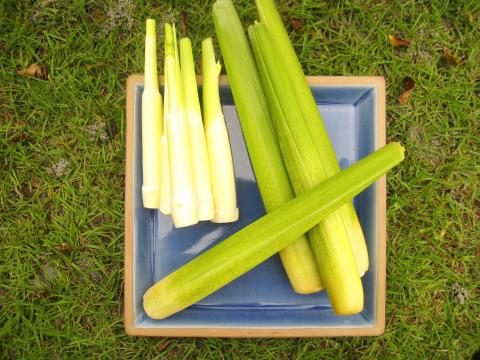For many years cooking and eating in Taiwan, I had never quite seen the point of water bamboo — or indeed really understood what it was. The name suggested that it was some kind of bamboo shoot and my own experience was that while pleasantly crunchy, it didn’t have much taste.
Yet I had often heard local friends praising this vegetable, and when I was given a bag full of locally grown water bamboo last month, I decided it was time to find out if I could incorporate it into my own cooking.
The first thing I discovered is that water bamboo is a tremendously misleading name for this product. The Council of Agriculture provides common English names that include water shoots, water oats and coba, while an exploration of English-language Web sites revealed names such as Manchurian wild rice and rice grass. They all refer to a plant that goes by the scientific name of Zizania latifolia.

The cultivation of Zizania latifolia goes back millennia and was once cultivated as a grain. It is now raised for its stems, which swell into what we all recognize as water bamboo when infected by the smut fungus Ustilago esculenta.
Experimenting with the bag of homegrown and freshly harvested water bamboo, I discovered its delightful nutty taste. As always, freshness and natural cultivation are key to flavorful vegetables, and nothing could be truer of the subtly flavored water bamboo. It is currently approaching the end of its growing season down south, but up north the 2014 New Taipei City Water Bamboo Festival (新北市茭白筍節) this weekend (today and tomorrow; visit ntpc.water-bamboo.tw/ for more information) is a last hurrah for the vegetable until next year.
During the main harvest in April and May, and again in August and September, water bamboo can easily be found in the supermarket, much of it from the main production center of Puli (埔里). My own experience with such store-bought produce has been disappointing, and probably suggests why many traditional preparations favor robust seasonings, making the vegetable little more than a vehicle to carry other flavors.

The health claims for eating water bamboo are numerous, and it is undoubtedly nutritious and an excellent source of dietary fiber. According to the Formosa Cancer Foundation, the nutrients gained from eating it are extremely beneficial for people with high blood pressure or diabetes.
Water bamboo is sold either in its husk or ready peeled. In the husk, the vegetable keeps for longer, and like corn, it can benefit from being cooked (usually steamed) directly in the husk. Once cooked, it can be chilled. Just peel off the husk to enjoy the cool, crunchy, nutty flesh inside. Another common preparation is to serve it shredded with pork, Auricularia auricula-judae (黑木耳, an edible fungus) and carrots, along with the usual stir-fry accompaniments of garlic, soy sauce, sesame oil and white pepper — a preparation in which the water bamboo does little more than provide texture.
The recipe that follows falls somewhere in between the above in regard to seasoning, and makes a great accompaniment for a simple dish of pan-fried pork chop with mashed potatoes.
Roasted salad with water bamboo and charred Chinese kale
Recipe (Serves 4 as a side dish)
Ingredients
8 stems water bamboo
8 baby corn
half a head cauliflower
8 pearl onions
8 leaves of Chinese kale
3 tablespoons extra virgin olive oil
salt and pepper to season
Directions
1. Peel off the tough outer husk of the water bamboo to reveal the soft white flesh. Peel off remaining bits of the fibrous husk with a sharp knife. Break up the head of cauliflower into florets.
2. Put water bamboo, baby corn, cauliflower florets and pearl onions in a baking tray. Season with salt and pepper, then toss with 2 tablespoon olive oil until evenly coated.
3. Place high in an oven preheated to 220 degrees Celsius for 15 minutes, tossing once or twice to avoid burning. A little bit of charring is fine.
4. Toss the Chinese kale leaves with salt, pepper and olive oil. Add to the roasting tray and mix with the other vegetables. Put back in the oven for 5 minutes. If your oven has a grill, you can turn on the element to provide more color and crisp the kale leaves.
5. Remove and serve.

Not long into Mistress Dispeller, a quietly jaw-dropping new documentary from director Elizabeth Lo, the film’s eponymous character lays out her thesis for ridding marriages of troublesome extra lovers. “When someone becomes a mistress,” she says, “it’s because they feel they don’t deserve complete love. She’s the one who needs our help the most.” Wang Zhenxi, a mistress dispeller based in north-central China’s Henan province, is one of a growing number of self-styled professionals who earn a living by intervening in people’s marriages — to “dispel” them of intruders. “I was looking for a love story set in China,” says Lo,

It was on his honeymoon in Kuala Lumpur, looking out of his hotel window at the silvery points of the world’s tallest twin skyscrapers, that Frank decided it was time to become taller. He had recently confessed to his new wife how much his height had bothered him since he was a teenager. As a man dedicated to self-improvement, Frank wanted to take action. He picked up the phone, called a clinic in Turkey that specializes in leg lengthening surgery — and made a booking. “I had a lot of second thoughts — at the end of the day, someone’s going

In the next few months tough decisions will need to be made by the Taiwan People’s Party (TPP) and their pan-blue allies in the Chinese Nationalist Party (KMT). It will reveal just how real their alliance is with actual power at stake. Party founder Ko Wen-je (柯文哲) faced these tough questions, which we explored in part one of this series, “Ko Wen-je, the KMT’s prickly ally,” (Aug. 16, page 12). Ko was open to cooperation, but on his terms. He openly fretted about being “swallowed up” by the KMT, and was keenly aware of the experience of the People’s First Party

Standing on top of a small mountain, Kim Seung-ho gazes out over an expanse of paddy fields glowing in their autumn gold, the ripening grains swaying gently in the wind. In the distance, North Korea stretches beyond the horizon. “It’s so peaceful,” says the director of the DMZ Ecology Research Institute. “Over there, it used to be an artillery range, but since they stopped firing, the nature has become so beautiful.” The land before him is the demilitarized zone, or DMZ, a strip of land that runs across the Korean peninsula, dividing North and South Korea roughly along the 38th parallel north. This